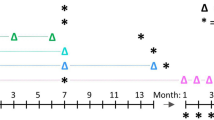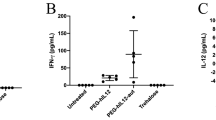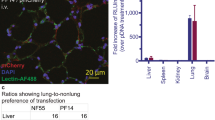Abstract
Delivery of genes to the lung has enormous potential in a wide variety of illnesses, from lung cancer to genetic deficiency diseases. Many delivery systems have been utilized, each with its own advantages and limitations. Polyethylenimine is a polycation capable of binding and compacting DNA, enabling intravascular plasmid delivery to normal tissues in such a way that the plasmid can be expressed in a proportion of the exposed cells. We have developed a novel intravenous method to deliver small amounts of plasmid to lung tissue, using nontoxic quantities of polyethylenimine in combination with albumin (or other soluble proteins). Injection of 1 μg or less of plasmid resulted in highly efficient gene expression in lung interstitial and endothelial tissues (0.5 to 1 ng luciferase per μg plasmid DNA), while larger quantities of plasmid reduced relative gene expression. Using luciferase as a reporter gene, single injections had maximal gene expression between 24 and 48 h, with a rapid decline thereafter. In contrast to some other delivery systems, however, no inhibition of gene expression occurred during multiple rounds of plasmid administration through 20 days. As a result, this method may have useful applications in diseases that could benefit from recurrent therapeutic gene delivery.
This is a preview of subscription content, access via your institution
Access options
Subscribe to this journal
Receive 12 print issues and online access
$259.00 per year
only $21.58 per issue
Buy this article
- Purchase on Springer Link
- Instant access to full article PDF
Prices may be subject to local taxes which are calculated during checkout









Similar content being viewed by others
References
Hantman M.J. et al. Antigen delivery systems: development of recombinant live virus vaccines using viral or bacterial vectors Ogra PL (eds); Mucosal Immunology Academic Press 1999 pp 779–791
Belyakov I.M., Moss B., Strober W., Berzofsky J.A. . Mucosal vaccination overcomes the barrier to recombinant vaccinia immunization caused by preexisting poxvirus immunity Proc Natl Acad Sci USA 1999 96: 4512–4512
Desrosiers R.C. . Safety issues facing development of a live-attenuated, multiply deleted HIV-1 vaccine AIDS Res Hum Retrovir 1994 10: 331–331
Fenner F. . Risks and benefits of vaccinia vaccine use in the worldwide smallpox eradication campaign Res Virol 1989 140: 465–465
Tan Y., Li S., Pitt B.R., Huang L. . The inhibitory role of CpG immunostimulatory motifs in cationic lipid vector-mediated transgene expression in vivo Hum Gene Ther 1999 10: 2153–2153
Li S., Rizzo M.A., Bhattacharya S., Huang L. . Characterization of cationic lipid-protamine-DNA (LPD) complexes for intravenous gene delivery Gene Therapy 1998 5: 930–930
Gautam A., Densmore C.L., Waldrep J.C. . Pulmonary cytokine responses associated with PEI-DNA aerosol gene therapy Gene Therapy 2001 8: 254–254
Dunlap D.D., Maggi A.S., Marco R., Monaco L. . Nanoscopic structure of DNA condensed for gene delivery Nucleic Acids Res 1997 25: 3095–3095
Ferrari S. et al. Polyethylenimine shows properties of interest for cystic fibrosis gene therapy Biochim Biophys Acta 1999 1447: 219–219
Boussif O. et al. A versatile vector for gene and oligonucleotide transfer into cells in culture and in vivo: polyethylenimine Proc Natl Acad Sci USA 1995 92: 7297–7297
Kichler A., Behr J.P., Erbacher P. . Polyethylenimines: a family of potent polymers for nucleic acid delivery Huang L, Hung MC, Wagner E (eds); Non-viral Vectors for Gene Therapy Academic Press 1999 pp 191–206
Goula D. et al. Polyethylenimine-based intravenous delivery of transgenes to mouse lung Gene Therapy 1998 5: 1291–1291
Godbey W.T. et al. Poly(ethylenimine)-mediated transfection: a new paradigm for gene delivery J Biomed Mater Res 2000 51: 321–321
Zou S.-M., Erbacher P., Remy J.-S., Behr J.-P. . Systemic linear polytheylenimine (L-PEI) mediated gene delivery in the mouse J Gene Med 2000 2: 128–128
Orson F.M. et al. Genetic immunization with lung-targeting macroaggregated polyethyleneimine-albumin conjugates elicits combined systemic and mucosal immune responses J Immunol 2000 164: 6313–6313
Gautam A. et al. Transgene expression in mouse airway epithelium by aerosol gene therapy with PEI-DNA complexes Mol Ther 2001 3: 551–551
Weiner G.J. et al. Immunostimulatory oligodeoxynucleotides containing the CpG motif are effective as immune adjuvants in tumor antigen immunization Proc Natl Acad Sci USA 1997 94: 10833–10833
Walker P.S. et al. Immunostimulatory oligodeoxynucleotides promote protective immunity and provide systemic therapy for leishmaniasis via IL-12- and IFN-gamma-dependent mechanisms Proc Natl Acad Sci USA 1999 96: 6970–6970
Densmore C.L. et al. PEI-DNA formulations for aerosol gene therapy Molec Ther 1999 1: 180–180
Boussif O., Zanta M.A., Behr J.P. . Optimized galenics improve in vitro gene transfer with cationic molecules up to a thousand-fold Gene Therapy 1996 3: 1074–1074
Kircheis R. et al. Coupling of cell-binding ligands to polyethylenimine for targeted gene delivery Gene Therapy 1997 4: 409–409
Godbey W.T., Wu K.K., Mikos A.G. . Size matters: molecular weight affects the efficiency of poly(ethylenimine) as a gene delivery vehicle J Biomed Mater Res 1999 45: 268–268
Godbey W.T., Wu K.K., Mikos A.G. . Poly(ethylenimine)-mediated gene delivery affects endothelial cell function and viability Biomaterials 2001 22: 471–471
Köping-Höggård M. et al. Chitosan as a nonviral gene delivery system. Structure-property relationships and characteristics compared with polyethylenimine in vitro and after lung administration in vivo Gene Therapy 2001 8: 1108–1108
Oh Y.-K. et al. Prolonged organ retention and safety of plasmid DNA administered in polyethylenimine complexes Gene Therapy 2001 8: 1587–1587
Bragonzi A. et al. Comparison between cationic polymers and lipids in mediating systemic gene delivery to the lungs Gene Therapy 1999 6: 1995–1995
Goula D. et al. Rapid crossing of the pulmonary endothelial barrier by polyethylenimine/DNA complexes Gene Therapy 2000 7: 499–499
McLachlan G., Stevenson B.J., Davidson D.J., Porteous D.J. . Bacterial DNA is implicated in the inflammatory response to delivery of DNA/DOTAP to mouse lungs Gene Therapy 2000 7: 384–384
Carson D.A., Raz E. . Oligonucleotide adjuvants for T helper 1 (Th1)-specific vaccination J Exp Med 1997 186: 1621–1621
Klinman D.M., Yamshchikov G., Ishigatsubo Y. . Contribution of CpG motifs to the immunogenicity of DNA vaccines J Immunol 1997 158: 3635–3635
McCluskie M.J., Davis H.L. . CpG DNA is a potent enhancer of systemic and mucosal immune responses against hepatitis B surface antigen with intranasal administration to mice J Immunol 1998 161: 4463–4463
Friemark B.D. et al. Cationic lipids enhance cytoking and cell influx levels in the lung following administration of plasmid: cationic lipid complexes J Immunol 1998 160: 4580–4580
Helander I.M., Latva-Kala K., Lounatmaa K. . Permeabilizing action of polyethylenimine on Salmonella typhimurium involves disruption of the outer membrane with lipopolysaccharide Microbiology 1998 144: 385–385
Klemm A.R., Young D., Lloyd J.B. . Effects of polyethyleneimine on endocytosis and lysosome stability Biochem Pharmacol 1998 56: 41–41
Kichler A., Leborgne C., Coeytaux E., Danos O. . Polyethylenimine-mediated gene delivery: a mechanistic study J Gene Med 2001 3: 135–135
Pollard H. et al. Polyethylenimine but not cationic lipids promotes transgene delivery to the nucleus in mammalian cells J Biol Chem 1998 273: 7507–7507
Godbey W.T., Wu K.K., Mikos A.G. . Tracking the intracellular path of poly(ethylenimine)/DNA complexes for gene delivery Proc Natl Acad Sci USA 1999 96: 5177–5177
Godbey W.T., Wu K.K., Hirasaki G.J., Mikos A.G. . Improved packing of poly(ethylenimine)/DNA complexes increases transfection efficiency Gene Therapy 1999 6: 1380–1380
Scheule R.K. et al. Basis of pulmonary toxicity associated with cationic lipid-mediated gene transfer to the mammalian lung Hum Gene Ther 1997 8: 689–689
Otake K., Ennist D.L., Harrod K., Trapnell B.C. . Nonspecific inflammation inhibits adenovirus-mediated pulmonary gene transfer and expression independent of specific acquired immune responses Hum Gene Ther 1998 9: 2207–2207
Yew N.S. et al. Contribution of plasmid DNA to inflammation in the lung after administration of cationic lipid:pDNA complexes Hum Gene Ther 1999 10: 223–223
Godbey W.T., Wu K.K., Mikos A.G. . Poly(ethylenimine) and its role in gene delivery J Cont Rel 1999 60: 149–149
Boletta A. et al. Nonviral gene delivery to the rat kidney with polyethylenimine Hum Gene Ther 1997 8: 1243–1243
Coll J.L. et al. In vivo delivery to tumors of DNA complexed with linear polyethylenimine Hum Gene Ther 1999 10: 1659–1659
Andersson S. et al. Cloning, structure, and expression of the mitochondrial cytochrome P-450 sterol 26 hydrolase, a bile acid biosynthetic enzyme J Biol Chem 1989 264: 8222–8222
Gautam A., Densmore C.L., Xu B., Waldrep J.C. . Enhanced gene expression in mouse lung after PEI-DNA aerosol delivery Mol Ther 2000 2: 63–63
Black H.S. et al. Dietary fat modulates immunoresponsiveness in UV-irradiated mice Photochem Photobiol 1995 62: 964–964
Acknowledgements
This work was supported by the Department of Veterans Affairs, the Huffington Foundation, the Center for AIDS Research and the Clayton Foundation for Research.
Author information
Authors and Affiliations
Rights and permissions
About this article
Cite this article
Orson, F., Song, L., Gautam, A. et al. Gene delivery to the lung using protein/polyethylenimine/plasmid complexes. Gene Ther 9, 463–471 (2002). https://doi.org/10.1038/sj.gt.3301666
Received:
Accepted:
Published:
Issue Date:
DOI: https://doi.org/10.1038/sj.gt.3301666



